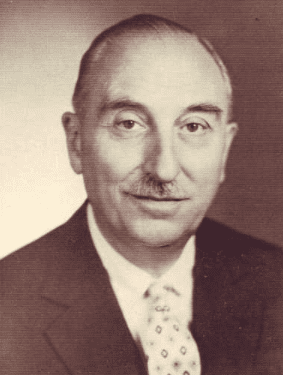Howard Fischer
Uppsala, Sweden
 |
| Giovanni Borromeo – Italian doctor – Righteous Among the Nations. Via Wikimedia. CC BY-SA 3.0 |
“Whoever saves one life, it is as if he saved the whole world.”
— Talmud (Mishnah Sanhedrin 4:5)1
Italy was an ally of Nazi Germany and was required to enact anti-Semitic laws.2 Beginning in September 1938, Jewish students were excluded from public schools, no new Jewish students could enter universities, and Jewish teachers were fired. Jews could no longer hold public-sector jobs. Jewish properties exceeding a specific value were expropriated, and Jews could not marry Aryans. This loss of civil status was expanded in 1939: Jewish physicians, dentists, veterinarians, and lawyers could only practice among Jews. Jewish journalists were dismissed, and Jews could not own radios. Jewish men were required to perform forced labor. Unlike other Nazi-allied or occupied countries, there were no deportations or concentration camp imprisonments for Italian Jews.
In 1943 Italy surrendered to the Allies, and the Wehrmacht occupied Italy to prevent an Allied invasion of Europe. Within a month of the German occupation in September 1943, the Jews of Rome were directly threatened by the Nazis. The Jewish ghetto of Rome was raided in October 1943. Jews were deported to the Auschwitz extermination camp.
The ghetto of Rome was near the Tiber River and close to the bridge leading to tiny Tiber Island, which lodged the Fatebenefratelli (“Do well, brothers”) Hospital. The hospital had been there for nearly four hundred years and was exempt from Italian law by its status of extraterritoriality, as it had been purchased from the Kingdom of Italy (1892) and belonged to the Hospitalier Order of St. John of God.
Jews fleeing the Nazi raids on the ghetto went to Tiber Island and were sheltered at the hospital. The chief of the hospital was Dr. Giovanni Borreomeo (1898-1961). He was aided in the protection of Jews by Friar Maurizio Bialek, Dr. Arriano Ossicini, and Dr. Vittorio Sacerdoti, a Jewish doctor who had obtained false identity papers so he could continue working at the hospital. The only way that the hospital could hide a large number of Jews, as well as some anti-fascist partisans and army deserters, was in plain sight. Thus, it was necessary to invent a terrible, contagious, fatal disease that would discourage German inspection of hospital wards. The patients that needed to be hidden were, therefore, diagnosed as having “syndrome K”3 (“morbo di K”), which could end in dementia and death from asphyxiation. Patients were instructed to cough nonstop when German inspectors came near. Doctors were masked, gowned, and gloved when they entered syndrome K isolation wards.
Why the name “syndrome K”? There are a few possible answers. The “K” might have been an insult aimed at Herbert Kappler, the SS colonel who was the police chief of Rome, or at Field Marshal Albert Kesselring, the commander of occupied Rome. The Germans thought that the “K” was for Koch, that is, Robert Koch the discoverer of the bacillus of tuberculosis, or that it was the “K” in Krebskrankheit, cancer.4,5
In any case, these contagious wards were never inspected. When a better hiding place for a Jew was found (usually in a convent), he “died” from syndrome K and a false death certificate was issued.6 No employee of the hospital ever informed the Germans that syndrome K was a ruse. It has been estimated that at least one hundred and perhaps several hundred Jews were saved by syndrome K.
After the war, Dr. Borreomeo was awarded the Order of Merit and the Silver Medal of Valor by the Italian government.7 He was also named one of “the righteous among nations” (2004) at Yad Vashem in Israel. The international Raoul Wallenberg Foundation said of the hospital: “This place was a beacon of light in the darkness of the Holocaust . . .”9
References
- George Weisz. “A group of Italian doctors save Jews during the Holocaust: an ingenious ploy,” IMAJ, 19, 2017.
- Susan Zucotti. Under his very windows: the Vatican and the Holocaust in Italy, New Haven: Yale University Press, 2002.
- Caitlin Hu. “An Italian doctor explains ‘syndrome K,” (morbo di K)- the fake disease invented to save Jews from Nazis” site: Syndrome K: The WWII-era “disease” that saved Jewish lives in Italy. Quartz, July, 2016.
- Francesco Buscemi. “K syndrome, the disease that saved,” History Today, 69; no.3, 2019.
- Lauren Pima. “Le syndrome K, la maladie imaginaire qui a sauvé des juifs en 1943, cultea.fr, 2021.
- Jean-Christophe Piot. “Morbo di K,” Histomède, esanum.fr, 2020.
- Kaushik Patowary. “Syndrome K: The fake disease that saved lives, Amusing Planet, November 2019.
- NA. “Syndrome K: The fake WWII disease that saved Jews from the Nazis,” Sky History Channel, ND.
- NA. “Syndrome K,” everything- everywhere.com Daily (Podcast) 2020.
HOWARD FISCHER, MD, was a professor of pediatrics at Wayne State University School of Medicine, Detroit, Michigan.
Highlighted in Frontispiece Volume 13, Issue 4 – Fall 2021
Summer 2021 | Sections | History Essays

Leave a Reply